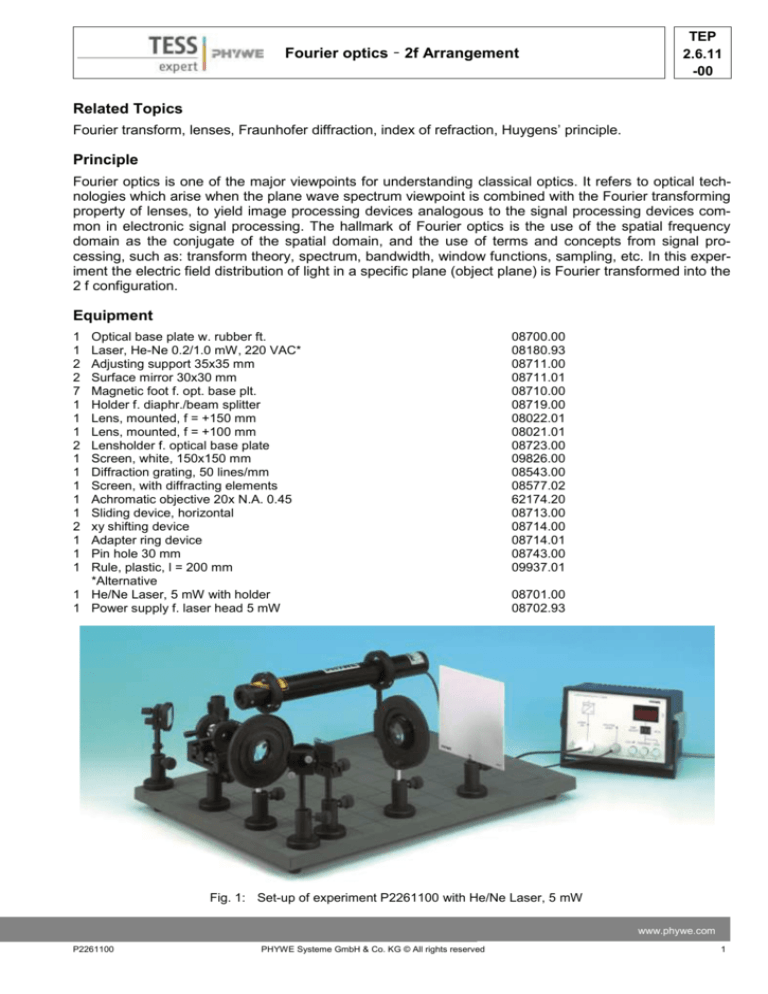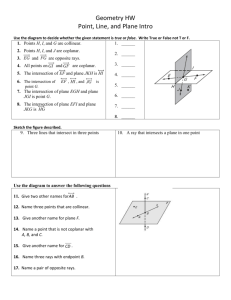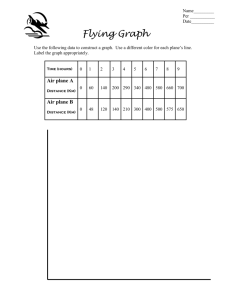
Fourier optics – 2f Arrangement
TEP
2.6.11
-00
Related Topics
Fourier transform, lenses, Fraunhofer diffraction, index of refraction, Huygens’ principle.
Principle
Fourier optics is one of the major viewpoints for understanding classical optics. It refers to optical technologies which arise when the plane wave spectrum viewpoint is combined with the Fourier transforming
property of lenses, to yield image processing devices analogous to the signal processing devices common in electronic signal processing. The hallmark of Fourier optics is the use of the spatial frequency
domain as the conjugate of the spatial domain, and the use of terms and concepts from signal processing, such as: transform theory, spectrum, bandwidth, window functions, sampling, etc. In this experiment the electric field distribution of light in a specific plane (object plane) is Fourier transformed into the
2 f configuration.
Equipment
1
1
2
2
7
1
1
1
2
1
1
1
1
1
2
1
1
1
Optical base plate w. rubber ft.
Laser, He-Ne 0.2/1.0 mW, 220 VAC*
Adjusting support 35x35 mm
Surface mirror 30x30 mm
Magnetic foot f. opt. base plt.
Holder f. diaphr./beam splitter
Lens, mounted, f = +150 mm
Lens, mounted, f = +100 mm
Lensholder f. optical base plate
Screen, white, 150x150 mm
Diffraction grating, 50 lines/mm
Screen, with diffracting elements
Achromatic objective 20x N.A. 0.45
Sliding device, horizontal
xy shifting device
Adapter ring device
Pin hole 30 mm
Rule, plastic, l = 200 mm
*Alternative
1 He/Ne Laser, 5 mW with holder
1 Power supply f. laser head 5 mW
08700.00
08180.93
08711.00
08711.01
08710.00
08719.00
08022.01
08021.01
08723.00
09826.00
08543.00
08577.02
62174.20
08713.00
08714.00
08714.01
08743.00
09937.01
08701.00
08702.93
Fig. 1: Set-up of experiment P2261100 with He/Ne Laser, 5 mW
www.phywe.com
P2261100
PHYWE Systeme GmbH & Co. KG © All rights reserved
1
TEP
2.6.1100
Fourier optics – 2f Arrangement
Tasks
Investigation of the Fourier transform by a convex lens for different diffraction objects in a 2f set-up.
In the first part Fourier spectra of following three diffraction objects should be investigated:
1) Plane wave
2) Long slit with finite width
3) Grid.
Set-up and Procedure
In the following, the pairs of numbers in brackets refer to the coordinates on the optical base plate in accordance with Fig. 1. These coordinates are intended to help with coarse adjustment. The recommended
set-up height (beam path height) is about 130 mm.
-
The E25x beam expansion system (magnetic foot at [1,6]) and the lens L0 [1,3] are not to be used for
the first beam adjustment.
-
When adjusting the beam path with the adjustable mirrors M1 [1,8] and M2 [1,1], the beam is set along
the 1,x and 1,y coordinates of the base plate.
-
Now place the E25x [1,6] beam expansion system without its objective and pinhole, but equipped instead only with the adjustment diaphragm, in the beam path. Orient it such that the beam passes
through the circular stops without obstruction.
-
Now replace these diaphragms with the objective and the pinhole diaphragm. Move the pinhole diaphragm toward the focus of the objective. In the process, first ensure that a maximum of diffuse light
strikes the pinhole diaphragm and later the expanded beam. Successively adjust the lateral positions
of the objective and the pinhole diaphragm while approaching the focus in order to ultimately provide
an expanded beam without diffraction phenomena.
-
The L0 [1,3] (f = +100 mm) is now positioned at a distance exactly equal to the focal length behind
the pinhole diaphragm such that parallel light now emerges from the lens. No divergence of the light
spot should occur with increasing separation. (testing for parallelism via the light spot diameter with a
ruler at various distances behind the lens L0 in a range of approximately 1 m).
-
Place a plate holder P1 [2,1] in the object plane.
-
Position the lens L1 [5,1] at the focus (f = 150 mm) and the screen SC [8,1] at the same distance behind the lens.
-
Note the terms of the “object plane” at P1 (blue) and the “Fourier plane” at the screen SC (red).
Note
This combination of basic qualitative experiments shows in the first part (this experiment) the Fourier
transformation for different diffraction objects. In the second part (Fourier optics – 4f Arrangement, LEP
2.6.12-00) it is shown how to use such a transformation to influence image properties. Since the time
needed for set-up and adjustment of the optical components is quite long, it is strongly recommended to
combine both experiments.
2
PHYWE Systeme GmbH & Co. KG © All rights reserved
P2261100
Fourier optics – 2f Arrangement
TEP
2.6.11
-00
Procedure
Place nothing, a slit and a gridError! Reference source not found. into the plate holder P1. as three different diffraction objects in the object plane. Observe their patterns in the Fourier plane and compare
them to the theoretical predictions.
(a) Plane wave
As a first partial experiment observe the plane wave itself (the light spot), i. e. no diffracting structures
are placed in the object plane. Sketch your observation in the Fourier plane SC.
According to the theory, a point should appear in the Fourier plane SC behind the lens. This is also the
focus; this fact can be checked by changing the screen distance from the lens.
(b) Long slit with finite width
Now clamp the diaphragm with diffraction objects into the plate holder P1 in the object plane. While doing
so, adjust its height and lateral position in such a manner that the light spot strikes the slit which has a
slit width of 0.2 mm. Sketch your observation in the Fourier plane SC. The Fourier transform of the slit
can be seen on the screen as the typical diffraction pattern of a slit (compare with the theory).
Fig. 1: Sketch of the experimental set-up (object plane: blue, Fourier plane: red)
(c) Grid
The diffraction grating (50 lines/mm) now serves as a diffracting structure; clamp it in the plate holder P1.
Conclusions about the slit separation can be made from the separation of the diffraction maxima in the
Fourier plane SC behind the lens L1 (see theory). Sketch your observation in the Fourier plane SC.
Theory
The Fourier transform plays a major role in the natural sciences. In the majority of cases, one deals with
www.phywe.com
P2261100
PHYWE Systeme GmbH & Co. KG © All rights reserved
3
TEP
2.6.1100
Fourier optics – 2f Arrangement
Fourier transforms in a time range, which supplies us with the spectral composition of a time signal. This
concept can be extended in two aspects:
1. In our case a spatial signal and not a temporal signal is transformed.
2. A two-dimensional transform is performed.
From this, the following is obtained:
+∞
𝐸̃ (𝜈𝑥 , 𝜈𝑦 ) = 𝐹̃ [𝐸(𝑥, 𝑦)](𝜈𝑥 , 𝜈𝑦 ) = ∫
+∞
∫
−∞
𝐸(𝑥, 𝑦)𝑒 −2𝜋𝑖(𝜈𝑥 𝑥+𝜈𝑦 𝑦) 𝑑𝑥𝑑𝑦
(1)
−∞
where νx and νy are spatial frequencies.
Scalar diffraction theory
In Fig. 3 we observe a plane wave which is diffracted
in one plane. For this wave in the xy plane directly behind the plane z = 0 with the following transmission
distribution τ (x,y):
𝐸(𝑥, 𝑦) = 𝜏(𝑥, 𝑦)𝐸𝑒 (𝑥, 𝑦)
Fig.3: A plane wave Ee(x,y) is diffracted in the plane with
where Ee(x,y): electric field distribution of the incident τ (x,y) for z = 0.
wave. The further expansion can be described by the
assumption that a spherical wave emanates from each point (x,y,0) behind the diffracting structure (Huygens’ principle). This leads to Kirchhoff’s diffraction integral:
(2)
𝐸(𝑥′, 𝑦′, 𝑧) =
1 +∞ +∞
𝑒 𝑖𝑘𝑟
∫ ∫ 𝐸(𝑥, 𝑦)
𝑐𝑜𝑠(𝑛⃑, 𝑟) 𝑑𝑥𝑑𝑦
𝑖𝜆 −∞ −∞
𝑟
with λ = spherical wave length
𝑛⃑ = normal vector of the (x,y) plane
k = wave number =
2𝜋
𝜆
Equation (2) corresponds to a accumulation of spherical waves, where the factor 1/(iλ) is a phase and
amplitude factor and cos (𝑛⃑, 𝑟) a directional factor which results from the Maxwell field equations.
The Fresnel approximation (observations in a remote radiation field) considers only rays which occupy a
small angle to the optical axis (z axis), i. e. |x|,|y|<<z and |x’|,|y’|<<z. In this case, the directional factor
can be neglected and the 1/r dependence becomes: 1/r = 1/z. In the exponential function, this cannot
be performed as easily since even small changes in r result in large phase changes. To achieve this, the
roots in
𝑟 = √(𝑥 ′ 𝑥)2 + (𝑦 ′ 𝑦)2 + 𝑧 2 = 𝑧 ∙ √1
(𝑥 ′ 𝑥)2 (𝑦 ′ 𝑦)2
+
𝑧2
𝑧2
are expanded into a series and one obtains:
4
PHYWE Systeme GmbH & Co. KG © All rights reserved
P2261100
TEP
2.6.11
-00
Fourier optics – 2f Arrangement
𝑟=𝑧+
(𝑥 ′ 𝑥)2 (𝑦 ′ 𝑦)2
+
2𝑧
2𝑧
This results in the Fresnel approximation of the diffraction integral
𝐸(𝑥′, 𝑦′, 𝑧) =
𝑖𝑘
𝑒 𝑖𝑘𝑧 +∞ +∞
′
′ 2
′
2
∫ ∫ 𝐸(𝑥, 𝑦)𝑒 2𝑧((𝑥 −𝑦 ) +(𝑦 −𝑦) ) 𝑑𝑥𝑑𝑦
𝑖𝜆 −∞ −∞
(3)
For long distances from the diffracting plane with concurrent finite expansion of the diffracting structure,
one obtains the Fraunhofer approximation:
+∞
𝐸(𝑥′, 𝑦′, 𝑧) = 𝐶(𝑥′, 𝑦′, 𝑧) ∙ ∫
+∞
∫
−∞
with 𝐶(𝑥′, 𝑦′, 𝑧) =
𝑒 𝑖𝑘𝑧
𝑖𝜆𝑧
∙𝑒
𝐸(𝑥, 𝑦)𝑒
2𝜋𝑖
𝑖𝑘 𝑥 ′ 𝑦 ′
( 𝑥− 𝑦)
2𝑧 𝜆𝑧 𝜆𝑧 𝑑𝑥𝑑𝑦
−∞
𝑖𝜋 ′2
(𝑥 −𝑦 ′2 )
𝜆𝑧
(4)
with the spatial frequencies as new coordinates:
𝑥′
𝑦′
𝜈𝑥 = 𝜆𝑧 ; 𝜈𝑦𝑥 = 𝜆𝑧
(5)
Consequently, the field distribution in the plane of observation (x’,y’,z) is shown by the following:
𝐸(𝑥′, 𝑦′, 𝑧) = 𝐶(𝜆𝑧𝜈𝑥 , 𝜆𝑧𝜈𝑦 , 𝑧) ̃𝐹 [𝐸(𝑥, 𝑦)](𝜈𝑥 , 𝜈𝑦 ) = 𝐸̃ (𝜈𝑥 , 𝜈𝑦 )
(6)
The electric field distribution in the plane (x’,y’) for z = const is thus established by a Fourier transform of
the field strength distribution in the diffracting plane after multiplication with a quadratic phase factor exp
((iπ /λz) (x2+y2)). The spatial frequencies are proportional to the corresponding diffraction angles (see
Fig. 4), where:
𝜈𝑥 =
𝑥 ′ tan 𝛼 𝛼
𝑦′
=
≈ ; 𝜈𝑦 =
𝜆𝑧
𝜆
𝜆
𝜆𝑧
tan 𝛽 𝛽
=
≈
𝜆
𝜆
Through the making of a photographic recording or
through observation of the diffraction image with
one eye, the intensity formation disappears due to
the phase information of the light in the plane Fig. 4: Relationships between spatial frequencies and
(x’,y’,z). As a consequence, only the intensity distri- the diffraction angle.
bution (this corresponds to the power spectrum) can
be observed. As a result the phase factor C (Equation 6) drops out of the operation. Therefore, the following results:
2
1
𝐼(𝜈𝑥 , 𝜈𝑦 ) = 𝜆2 𝑧2 |𝐹̃ [𝐸(𝑥, 𝑦)](𝜈𝑥 , 𝜈𝑦 )|
(7)
www.phywe.com
P2261100
PHYWE Systeme GmbH & Co. KG © All rights reserved
5
TEP
2.6.1100
Fourier optics – 2f Arrangement
Fourier transform by a lens
A biconvex lens exactly performs a two-dimensional
Fourier transform from the front to the rear focal
plane if the diffracting structure (entry field strength
distribution) lies in the front focal plane (see Fig. 5).
In this process, the coordinates υ and u correspond
to the angles β and α with the following correlations:
𝑥′
𝜈𝑥 = 𝜆𝑧 =
𝜈𝑥𝑦 =
𝛼
𝜆
Fig. 5: Experimental set-up with supplement for direct
measurementof the initial velocity of the ball.
𝑢
= 𝜆𝑓
𝐵
𝑦′ 𝛽
𝜐
= =
𝜆𝑧 𝜆 𝜆𝑓𝐵
(8)
This means that the lens projects the image of the remote radiation field in the rear focal plane:
+∞
𝐸̃ (𝑢, 𝜐) = 𝐴(𝑢, 𝜐, 𝑓𝐵 ) ∙ ∫
+∞
∫
−∞
𝐸(𝑥, 𝑦)𝑒
2𝜋𝑖(
𝑢
𝜐
𝑥−
𝑦)
𝜆𝑓𝐵 𝜆𝑓𝐵 𝑑𝑥𝑑𝑦
(9)
−∞
The phase factor A becomes independent of u and v, if the entry field distribution is positioned exactly in
the front focal plane. Thus, the complex amplitude spectrum results:
𝐸(𝑢, 𝜐)~𝐹̃ [𝐸(𝑥, 𝑦)](𝑢, 𝜐)
Again the power spectrum is recorded or observed:
(10)
2
2
𝐼(𝑢, 𝜐) = |𝐸̃ (𝑢, 𝜐)| ~|𝐹̃ [𝐸(𝑥, 𝑦)]|
It, too, is independent of the phase factor A and thus becomes independent of the position of the diffraction structure in the front focal plane. Additionally, equation 8 shows that the larger the focal length of the
lens is, the more extensive the diffraction image in the (u,υ) plane is.
Examples of Fourier spectra
(a) Plane wave:
A plane wave which propagates itself in the direction of
the optical axis (z axis) (Fig. 6) is distinguished in the object plane – (x,y) plane – by a constant amplitude. Thus,
the following results for the Fourier transform:
6
Fig. 6: Spectra of a plane wave.
(a) for the direction of light propagation parallel to the optical axis.
(b) for slanted incidence of the plane wave with reference
to the optical axis.
PHYWE Systeme GmbH & Co. KG © All rights reserved
P2261100
TEP
2.6.11
-00
Fourier optics – 2f Arrangement
𝐸(𝑥, 𝑦) = 𝐸0
+∞
𝐹̃ [𝐸(𝑥, 𝑦)] = ∫
+∞
∫
−∞
−∞
𝐸0 𝑒 −2𝜋𝑖(𝜈𝑥 𝑥+𝜈𝑦 𝑦) 𝑑𝑥𝑑𝑦 = 𝐸0 ∙ 𝛿𝜈𝑥 𝛿𝜈𝑦
(11)
This is a point on the focal plane at (νx,νy) = (0,0), which shifts at slanted incidence by an angle B to the
optical axis on the rear focal plane (see Fig. 6) with νx = sinα/λ.
Sample results
Object plane
Fourier plane
Theoretical prediction
Fig. 7: Fourier transformation of a plane wave
(b) Infinitely long slit with finite width
If the diffracting structure is an infinite slit which is transilluminated by a plane wave, this slit is mathematically described by a rectangular function rect perpendicular to the slit direction and having the same
width a:
𝑥
1 𝑓𝑜𝑟 |𝑥|<𝛼⁄2
𝐸(𝑥, 𝑦) = 𝑟𝑒𝑐𝑡 ( ) = 𝐸0
𝛼
0 𝑜𝑡ℎ𝑒𝑟𝑤𝑒𝑖𝑠𝑒
{
In the rear focal plane the following spectrum then results:
+∞
𝐹̃ [𝐸(𝑥, 𝑦)] = ∫
−∞
+a/2
𝑒 −2𝜋𝑖(𝜈𝑥 𝑥+𝜈𝑦 𝑦) 𝑑𝑥𝑑𝑦 = 𝐸0 ∙ 𝛿(𝜈𝑦 )
∫
−a/2
sin(π ∙ 𝜈𝑥 a)
π ∙ 𝜈𝑥
(12)
= 𝐸0 ∙ a𝛿(𝜈𝑦 ) sinc(a ∙ 𝜈𝑥 )
with the definition of the slit function “sinc“:
sinc(x) =
sin(π ∙ x)
π∙x
For infinitely long extension of the slit, one obtains
on extension in the slit direction in the spectrum.
This changes for a finite length of the slit. The zero
points of the Sinc function are located at …– 2/a, – Fig. 8: Infinitely long slit with the width a and its Fourier
spectrum.
1/a, 1/a, 2/a, ...(see Fig. 8).
www.phywe.com
P2261100
PHYWE Systeme GmbH & Co. KG © All rights reserved
7
TEP
2.6.1100
Fourier optics – 2f Arrangement
Sample result:
Object plane
Fourier plane
Theoretical prediction
Fig. 9: Fourier transformation of a slit
(c) Grid:
A grid is a composite diffracting structure. It consists of a periodic sequence (to be represented by a socalled comb function “comb“) of individual identical slit functions sinc.
The grid consists of M slits having a width a and a slit separation d (>a) in the x direction. As a result, the
field strength distribution can be in the front focal plane can be represented as follows:
𝑀
𝑀
𝑚−1
𝑚−1
𝑥 𝑚∙𝑑
𝑥
𝐸(𝑥, 𝑦) = 𝐸0 ∑ 𝑟𝑒𝑐𝑡 ( −
) = 𝐸0 [ ∑ 𝛿(𝑥 − 𝑚 ∙ 𝑑)] ∗ 𝑟𝑒𝑐𝑡 ( )
𝑎
𝑎
𝑎
where the Fourier transform of a convolution product (E1*E2) is given by:
𝐹̃ [(𝐸1 ∗ 𝐸2 )(𝑥, 𝑦)](𝜈𝑥 , 𝜈𝑦 ) = 𝐹̃ [𝐸1 (𝑥, 𝑦)](𝜈𝑥 , 𝜈𝑦 ) ∙ 𝐹̃ [𝐸2 (𝑥, 𝑦)](𝜈𝑥 , 𝜈𝑦 )
Using the calculation rules for Fourier transforms, the following spectrum results in the rear focal plane of
the lens:
𝑀
sin(𝜋𝑎𝜈𝑥 )
sin(𝜋 ∙ 𝑀 ∙ 𝑑𝜈𝑥 )
𝐹̃ [𝐸] = 𝐸0 ∙ 𝛿(𝜈𝑦 ) ∙
∑ 𝑒 −2𝜋𝑖 𝑚∙𝑑𝜈𝑥 = 𝐸0 ∙ 𝛿(𝜈𝑦 ) ∙ 𝑎 ∙ sinc(𝑎𝜈𝑥 )𝑒 −𝜋𝑖 𝑑𝜈𝑥 (𝑀+1) ∙
𝜋𝜈𝑥
sin(𝜋 ∙ 𝑑𝜈𝑥 )
𝑚−1
(13)
Due to the intensity formation, the phase factor is cancelled:
𝐼(𝜈𝑥 , 𝜈𝑦 ) = |𝐸0 |2 ∙ 𝛿(𝜈𝑦 ) ∙ 𝑎2 ∙ sinc 2 (𝑎𝜈𝑥 ) ∙
8
sin2 (𝜋 ∙ 𝑀 ∙ 𝑑𝜈𝑥 )
sin2(𝜋 ∙ 𝑑𝜈𝑥 )
PHYWE Systeme GmbH & Co. KG © All rights reserved
(14)
P2261100
Fourier optics – 2f Arrangement
TEP
2.6.11
-00
In Fig. 10, a grid with its corresponding spectrum
(and the corresponding intensity distributions) is
presented.
One sees on the spectrum that the envelope curve
is formed by the spectrum of the individual slit
which has a width a. The finer structure is produced by the periodicity, which is determined by
Fig. 10: Grating consisting of M slits and its Fourier
the grid constant Md.
spectrum.
Sample results
Object plane
Fourier plane
Theoretical prediction
Fig. 11: Fourier transformation of a grid
www.phywe.com
P2261100
PHYWE Systeme GmbH & Co. KG © All rights reserved
9










